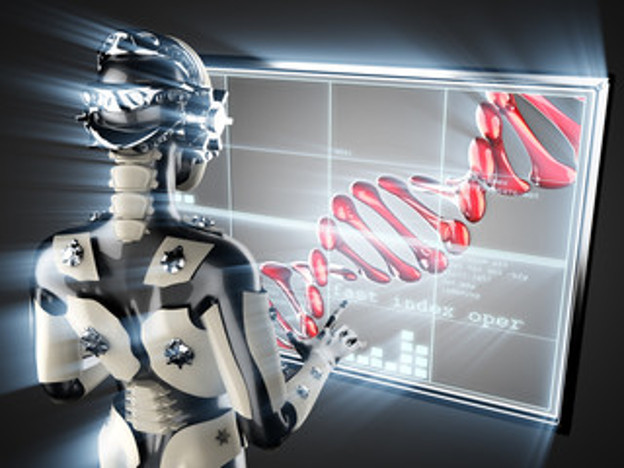Alexandra Daisy Ginsberg: An engineering Eve in the garden of ectopia

In her brief story “She Unnames Them,” Ursula K. Le Guin recasts Eve the primal mother as a primal liberator subverting the process of Adam’s animal-labeling. Bio-artist Alexandra Daisy Ginsberg is pursuing a related task, engaging in acts of transgenesis, regenesis, and intergenesis via computer simulations and 3D models of newly proposed creatures. Ginsberg is a self-declared Artist of the Sixth Mass Extinction, a designer instead of a protector of biodiversity, a conservationist who works via novelty rather than nurturance.
Ginsberg’s “Design Taxonomy” is a mode of engineering based on biological principles. Her slug-resembling Mobile Bioremediation Unit deacidifies polluted soil, while her porcupine-emulating Autonomous Seed Disperser is a quilled land rover aiding in woodland fertility. In several interlinked acts of witty and visionary hubris, Ginsberg creates new organisms intended to serve some targeted utility in a biome’s complex web. This art frequently flouts and queries an unwritten but omnipresent law: in nature, too-singular purpose always risks some underlying peril.
Ginsberg is a forward-looking preservationist pursuing and promoting techno-agrarian “robocrops,” “e. chromi” bioluminescent gut colonies of bacteria that monitor for disease, and DNA enhanced with non-biodegradable proteins. She asks if “rewilding” can be guided by the human hand and prompts questions concerning the potential dangers that ensue when patented, purpose-specific species are released into nature. She likewise asks, “If nature is totally industrialized for the benefit of society … will nature still exist for us to save?”, a question intoned with an odd mixture of faux arrogance and ironic idealism. Waging war on invasive species with half-invited species is an exercise in risk: designer organisms created to slip in between predator niches possess a nearly post-natural hardiness and competitive edge, and presumably send out unpredictable ripples across nature’s collective gene pool.
Similar to poets like Marianne Moore and Elizabeth Bishop, Ginsberg is working on her own career-spanning bestiary, an ensemble of handcrafted companion species “modeled on fungus, bacteria, invertebrates, and mammals.” She refers to consulting the “vast DNA library” to determine what new volumes that library needs to acquire. To this end, Ginsberg discusses PH-sensor bacteria programmed with a twenty-eight-day genetic kill-switch, self-inflating membrane pumps outfitted with non-return valves to inject oaks with spore serums, and microbe vats breeding swarms capable of drinking up oil spills. All of this activity accelerates the tempo of evolution by responding to perceived gaps and shortfalls in a biosphere. Operating on the precarious brink between “genres” of being but also between the living and the non-living, Ginsberg’s disposable cups made from fingernail keratin and printer’s ink made from dental plaque narrow the line between what we “are” and what we “use.”
Ginsberg playfully predicts a new branch on the Tree of Life — “Synthetica” — to supplement Archaea, Bacteria, and Eucarya. This branch would be a billowing, tentacular “spaghetti kingdom” grown on and from the elder branches of Plant and Animal. Ginsberg’s beta-level “dream of better” creates stand-ins for disappeared creatures, leaping over patent boundaries and the deliberate pace of organic evolution in a single hurdle, all the while opening up provocative fissures in eco-morality.
Ginsberg’s “Design is the transmission of ideas through things” sounds like a variation on William Carlos Williams’s “no ideas but in things,” but with a pivot away from imagery into embodiment. Her artwork “is turning to the living kingdoms for their materials library” and envisions the human body as a “biological chassis” on which to mount new consumer options and supplements. Ginsberg imagines deliberate and voluntary “synthetic infections” in which microbes assisted by plasmid rings manufacture new goods inside our viscera’s well-heated laboratory, and foresees bacterial hard drives inserted into the body to tally cell division and prevent cancer formation.
“So many mutants, so many potential products” is a self-deprecating Ginsberg mantra, though she also lampoons a “Tree of Life meets the NASDAQ” approach to genetics. Even more satirically, she proposes a “colonic alchemy” able to convert human waste into gold and goods-producing molecular orgies conducted along microbes’s “conjugal bridges” and “jelly ramps.”
These meta-utopian musings cover over a truly future-leaning tendency in Ginsberg’s work. If most of human creativity (including the publication of books) entails some degree of natural damage, Ginsberg’s brink-straddling art is devoted to a more constructive and healing impact on the elements, even as said healing potentially puts new hazards into play. This dramatizes the double- (and triple-, and quadruple-) edged nature of all human interventions into our host environment, and the venues and dangers that open outward as our material reality grows ever more scripted.
A p.s. to Genesis: notes on transgenic/bio-poetic art